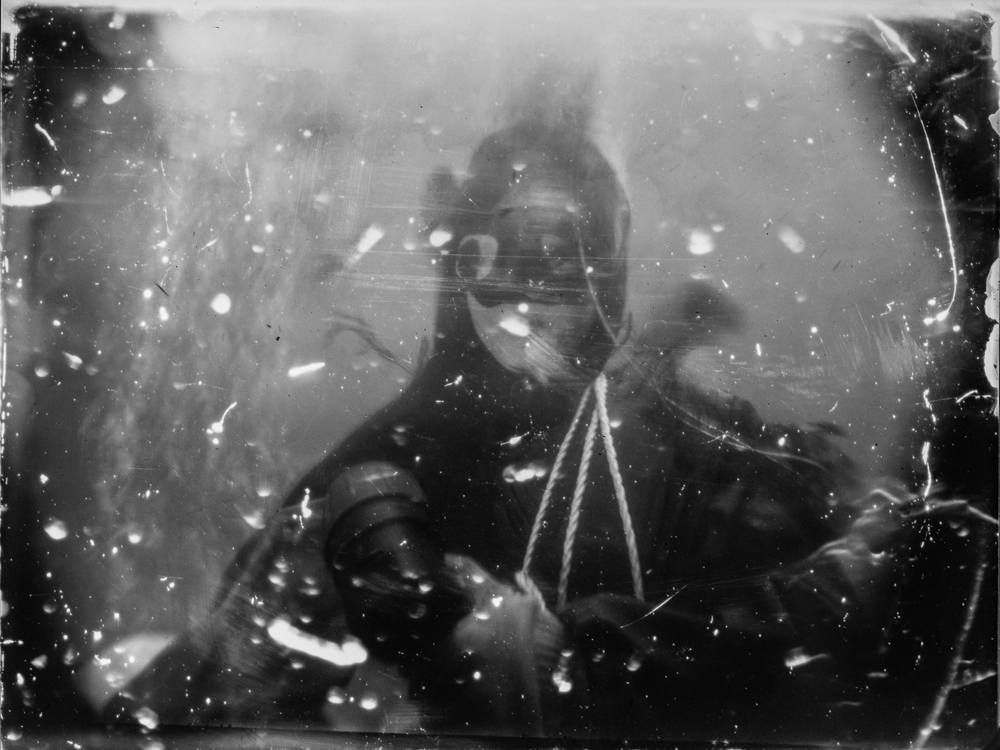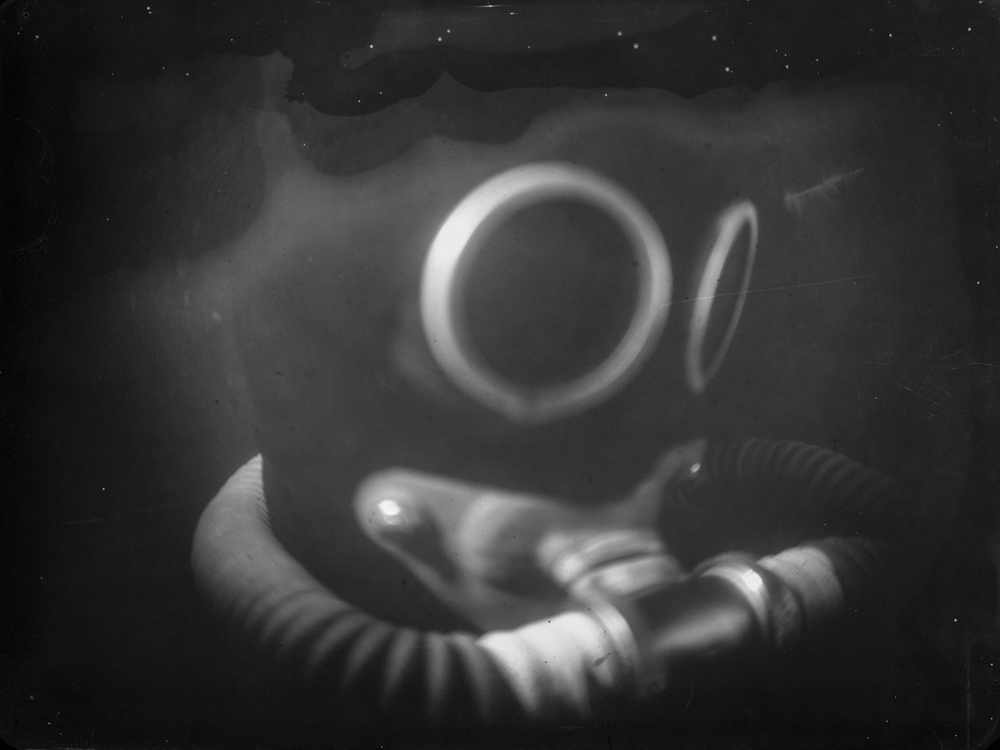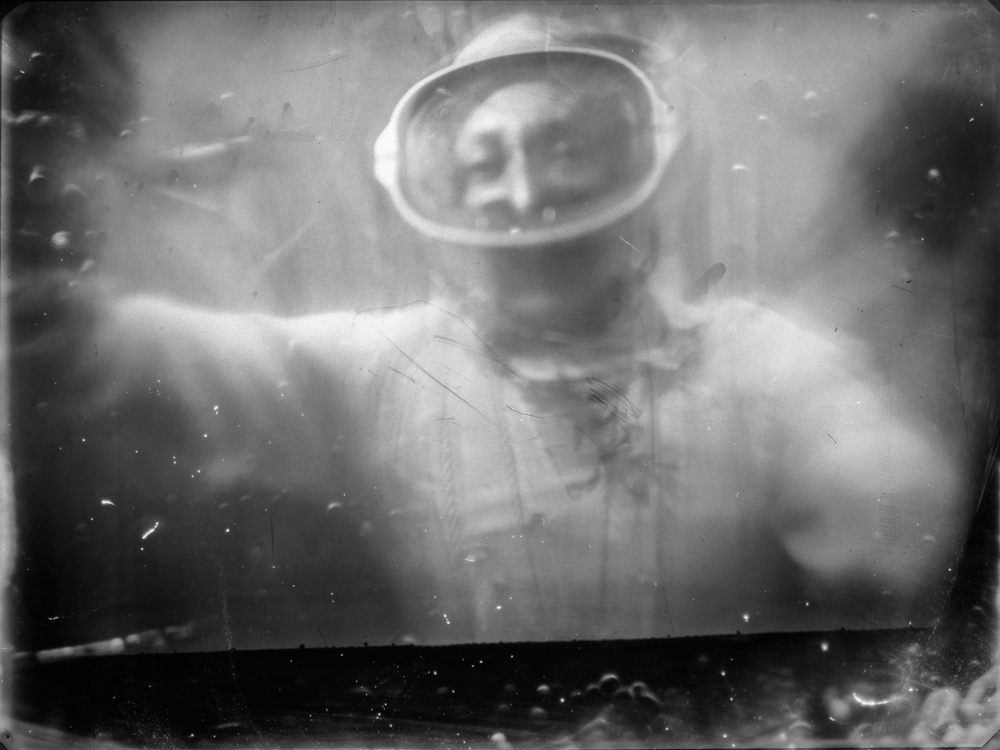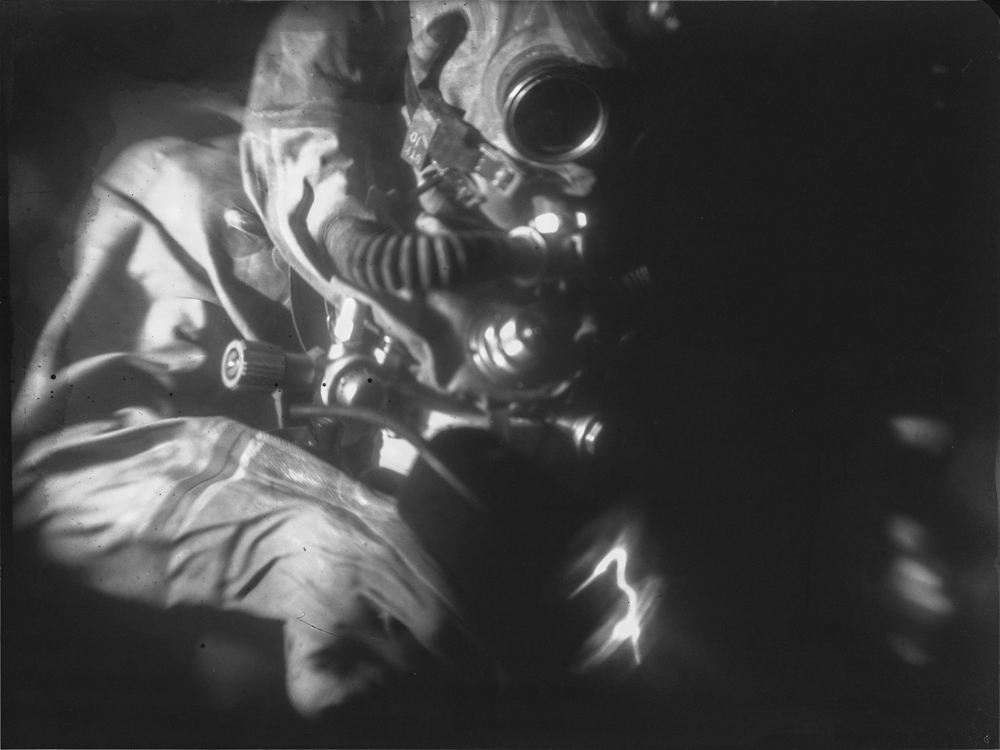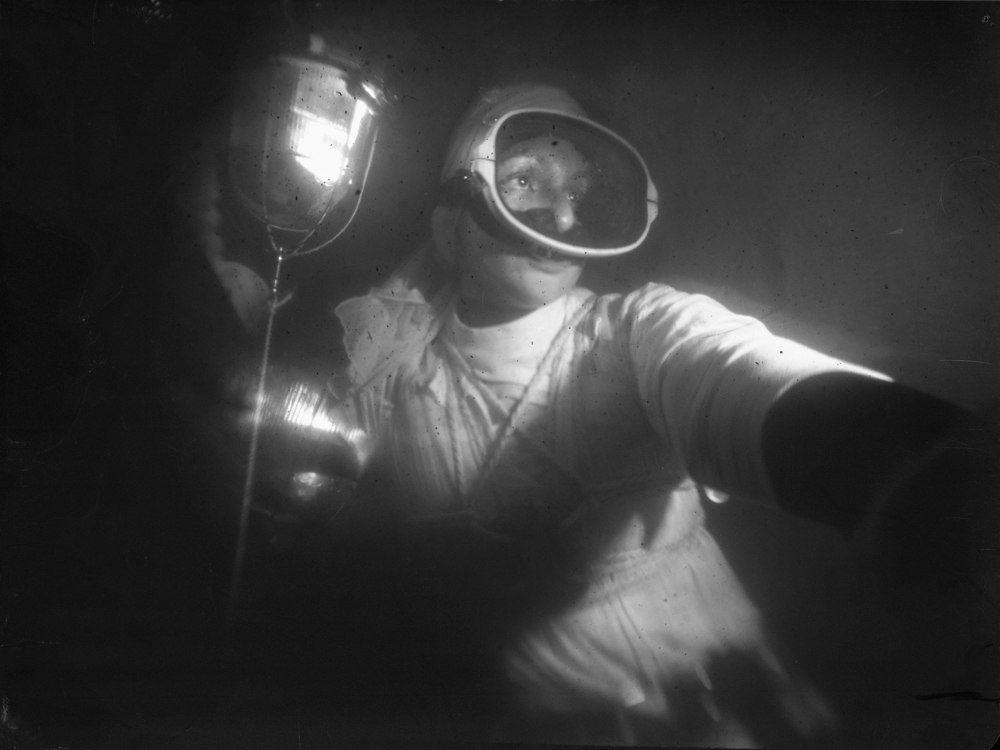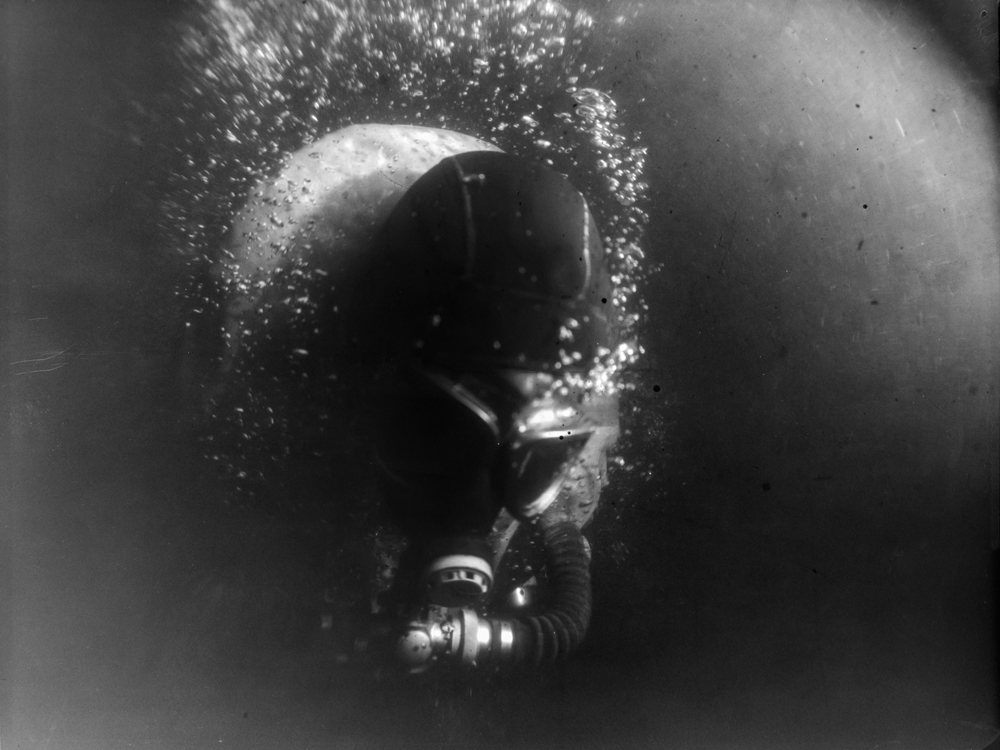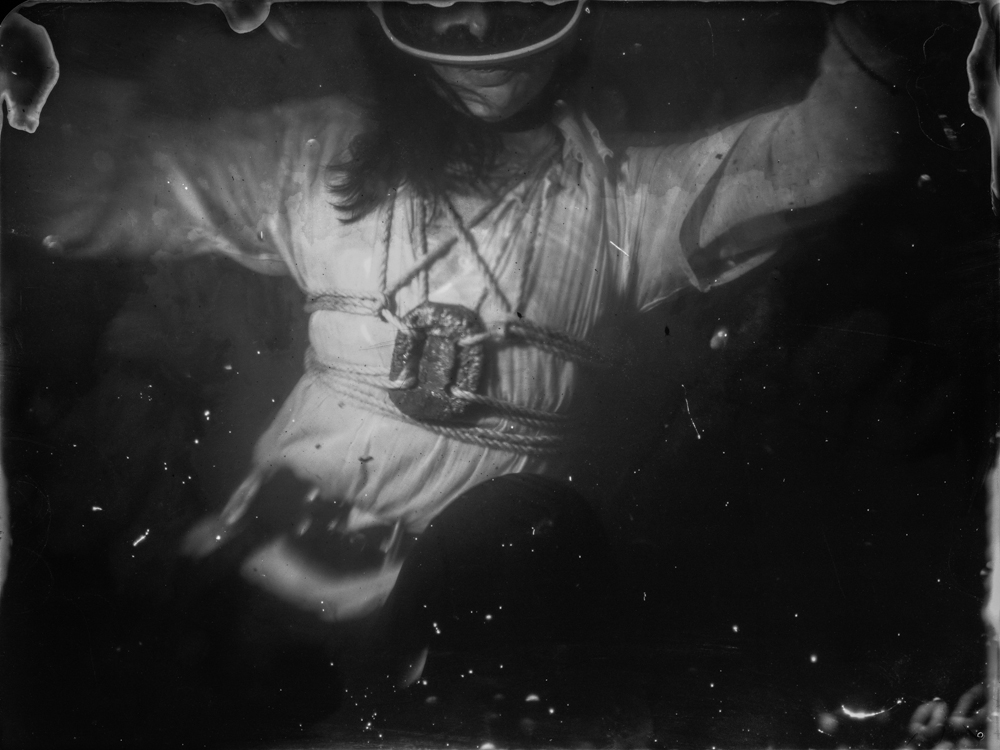The photographs made with the film large format cameras still remain popular nowadays. Herewith the story of the underwater large format seems to be unrevealed. After the works of Louis Boutan, Jacob Reighard and other researchers in the late XIX – early XX centuries the use of large format cameras for underwater shooting has stopped. Since that times almost nobody has taken the photographs using this technique. Working on this project we had a chance to continue the story of the subaquatic large format. For our part we saw a high potential in such shooting technique. We decided not to use the sealing of the camera, this decision gave us the opportunity to work with our camera under the water as if it were on land. Also thanks to this we realized our project at most rough conditions: in the North, far from the sea, with the simple equipment.
The presented photos are made under the water using only a hand-made 18 X 24 cm box camera.
Our goal was to achieve simplicity and candor in our photos to be distinguished in their pattern, mood and technical imperfectness from the gloss of modern digital images. We sought to explore the possibilities of old film-shooting techniques and their aesthetic qualities. The same purpose led us to use old-fashioned diving equipment as we searched for inspiration among traditional divers, such as Japanese ama and Korean Haenyeo; first light divers, military divers, and scuba divers researchers.
Simple archaic pictures provoke strange feelings and mystic images, something enigmatic, gothic, masquerade. Masks covering the face, ropes around the body, baggy dry suites, hoses, straps, mouth pieces, and nodes… Like a weighted puppet sinking into the water, where it has the minimal reserve of oxygen and no visibility… The water pressure rising with every meter closer to the lake floor… The light fading away… The temperature dropping… Fear, loneliness, isolation. In a world where a human is a stranger, the diver has to act against his instincts. It is a hostile and dangerous world that does not forgive mistakes or panic. But if you overcome the dark side and if your desire to push the limits is stronger than your fears, you will discover other space, the one of silence and tranquility. Something soothing and calming, charming, beautiful, bright and inviting. The Ocean is great. Its underworld is peculiar, mysterious and multifaceted.
With this project we wanted to honor the first underwater photographers who opened the door for us into this world. We conducted the project against the rules, with no expert help, safety equipment or experience. However, this allowed us to go backward, to return in times when those rules were created, and to appreciate the efforts of the pioneer underwater photographers. By resorting to obsolete simple technologies, both in photography and diving, we tried to recreate the conditions when the human had to rely on his intelligence, memory, senses and intuition, rather than a computer.
The fruit of our work is a series of black-and-white photographs that evoke rather contradictory emotional associations. The use of a monocular and a pinhole, large format film, contact print, the artifacts on the images and the absence of mechanical shutter allow for artistic originality of the photographs and reveal unexpected angles of the images.
Our project fills up the possibilities of underwater photography with the simple and original technique, amplifies the artistic, aesthetic and technical variety of subaquatic shooting, allows the large format camera to take same place under the water as it has on land.
Shooting location
The shooting was carried out in the Svetlenkoe lake in the North-West of Siberia near the city of Surgut. The water temperature during the shooting period (from June to October 2017) ranged from 20 C in summer to 3 C in fall.
The choice of a shooting location became our first challenge. Despite numerous water basins around (rivers, canals, swamps and lakes), it turned out to be a difficult task to find the right site with clear water, easy access and proximity to the city. Nevertheless, we had luck and, with the help of local divers, found a clear lake that met all the requirements.
Equipment
Our camera is a sliding box with a monocular lens and no mechanical shutter. Film (we used X-Ray) format is 18 x 24 cm (7 х 9,5’’). We made five film-holders, in which the film was covered by the glass. We don’t use waterproof box or other sealing of the camera, so during the shooting process it was fully filled with the water. We used ikelite DS 51 flash and a couple of simplest flashes and light synchronizers in a hand-made waterproof lantern as the source of light. The ikelite flash was attached to the Nikon D90 camera in waterproof case, which allowed us to shoot not only backstage but also helped to define the exposure and the power of the flash for the film.
Gradually, we acquired two dry diving suits from military divers’ arsenal, a rebreather IDA-59M, a 50-years-old scuba. Much of our gear was hand-made: weights, straps, lighting system, tripods.
All immersions were done in a free diving mode, without refilling scuba and rebreather. In order to breathe oxygen and to hold breath during the immersion we used integrated valve switch.
Evgenii Bashta – Commercial and art photographer. «Archaic black-and-white images created with simple obsolete cameras bear softness, artefacts and technical imperfectness and seem unexplicably attractive to me, lure with their softness. Their unique, sometimes naive charm, touches my heart. I have pursued the idea to create photo images with the simplest tools for a long time. And given my experience in underwater photography, I wanted to do it in the water. After studying how the old cameras worked, I realized that there was no need to make the camera itself waterproof; it was enough just to isolate the film. In 2017, Polina Petrenko and I decided to bring this idea into life. We assembled a test camera, made several cassettes/film-holders, found a suitable lens and began shooting sessions in June. As Polina had no previous diving experience, it was a very challenging experiment for her. She had to learn how to dive, how to use the gear, how to take pictures and manage the camera under water, how to be a model.
We had to immerse simultaneously, to assume the correct pose by the camera, to lift the dark slide, to stay still, to turn the flash on…all this had to be done in darkness and in heavy gear, while holding the breath and spotting each other with the sandy bottom often being stirred up and visibility dropping. Just five shots. Sometimes, the whole session was ruined. We would make errors with flash and exposure time, our films would become wet, the dark slide would get stuck, we would not be able to focus on the subject. But despite these small failures, our strong wish to go ahead and passion for our project gave its results – you can see the fruit of our efforts on our website».
Polina Petrenko – Documentary and event photographer. «I believe that an image exposed on film bears more life and sincerity. It is like comparing a print book to an electronic reader. The smell, the rituals, related to the developing and printing; the carefulness required to prepare and carry out the shooting… the whole process is fragile and categorical at the same time. One has a narrower margin of error. Everything must be done right from the beginning. In our case, we were even more limited, as we made our photographs under water with a film camera for an 18 X 24cm format. We had only 5 film-holders. Of course, first experiments were not that successful and sometimes funny. But the limitations of this technique made us more careful; we had to prepare in advance, to make test shots, to calculate error in lighting, to carry a huge load of equipment and gear that could be potentially useful. What is especially fascinating about the project is that we had to combine multiple skills and tasks to create these photographs. We were camera designers, engineers and builders (it is mostly Evgenii’s merit), physicists, opticians, purchasing agents, divers, loaders, drivers, printers and, of course, photographers and models. Besides, this project allowed me to continue my documentary photography work. We dived and shot under the rain, storm or snow, as I rushed to tell about it in my snapshots. You can find pictures with our backstage photographs on our website».
The team work with Evgenii Bashta has started just after our meeting in spring 2016. The first common point of interest we found in our mutual passion for the history, nature and indigenous people of the region we both moved not long ago. I moved from Moscow in 2011, Evgenii slightly earlier came back to the native city after a long-term project in other region. Very soon we have started to work on the basically documentary project “NOMAD CAT” about Ugra region and its local people – khanty and mansi; and still we proceed with its developing. Attending national holidays, khantys’ camps, forests and small towns of the region we spent in the car a lot of time, so we had a chance to discuss our ideas, photographic preferences. As for the other photographers of the same age, my photographic story has started from the analog process. But with the progress of the digital technique my passion for the film images remained alive, so during our trips I shared my emotions with Evgenii. In March on our way back from reindeer breeder holiday Evgenii for the first time has mentioned his idea of the underwater large format shooting. It seems I was annoying enough with my cliché about the particular charm of the film photography that my colleague at least decided that I could be his ally in this almost impossible project.
Evgenii tells about the birth of the underwater large format idea: “All has started with the pinhole. I was so fascinated with the pinhole idea, that immediately I decided to try. But from the beginning I renounced the variants of the cameras from matchboxes or similar ideas. It was so clear for me that the shooting has to be done with the large format only. Then I set sights on the underwater pinhole, herewith I couldn’t think about the standard cameras, in my head there was the image of the large format only. By the way from very beginning I thought about the sealing of the whole camera. Plus, I planned to paint out the glass of the lenses with the black color and then to make the hole in this paint. But I doubt about the glass that could change the optic characteristics of the pinhole. This idea leaded me to the following question – do we really need the sealing? what should we seal in the empty box? The decision came just after, I realized that it was enough to make the sealing of the film, and other parts like lenses, simple shutter can work in the water. But it was so long time ago, 5-6 years probably”.
After that conversation maybe, several times we were coming back to the discussion of the underwater large format idea. But as it usual happens we were too busy with the current work, actually we didn’t believe in the realization of such demanding project. On the other hand, the idea was already born and it was growing and waiting for the right minute of the start. And it happened just like that. One day being off the city for the work issues I received the message from Evgenii that having such pause in our mutual work he had started the construction of the camera. It was in August of 2016. Very soon the camera and two first film holders were already done.
The camera is done for the 18×24 cm film size and practically is the simple sliding box.
In the meantime, we have started first experiments with the monocular lenses and pinhole, in the totally dry studio and outdoors for the beginning.
Simultaneously with the above said experiments we have started the construction of the larger format camera (40 x 40 cm). We had the idea to use it for the first underwater shooting. This camera has traditional design with the movable boards and the bellow between it. This design decision despite the larger camera’s size makes it more mobile and compact in transportation. Also, it gives more possibilities for the shooting parameters regulation.
Also in the studio we made first experiments with the new camera, still unfinished. We used both monocular lenses and pinhole.
The shooting under the water we started in June 2017. First of all, we had to choose a suitable place for diving – not too far from the city, with the transparent water and the easy approach to the shore. With the help of local diver club, we found the lake with the transparent water close to the big gas power plant. And so, we’ve started the exploration of this lake in order to find the suitable shooting spots. The other interesting feature of the lake is the trunks you can see above the water. The lake was not really deep and probably it is the flooded forest with many snags. These snags under the water covered with silt and waterweeds impressed us by its fantastic and mythical view. The shoal of rivers perch came very close to the shore – there were not a lot of fishermen because of the relatively small lake size and the numerous snags.
Website: www.uwlfpics.com





